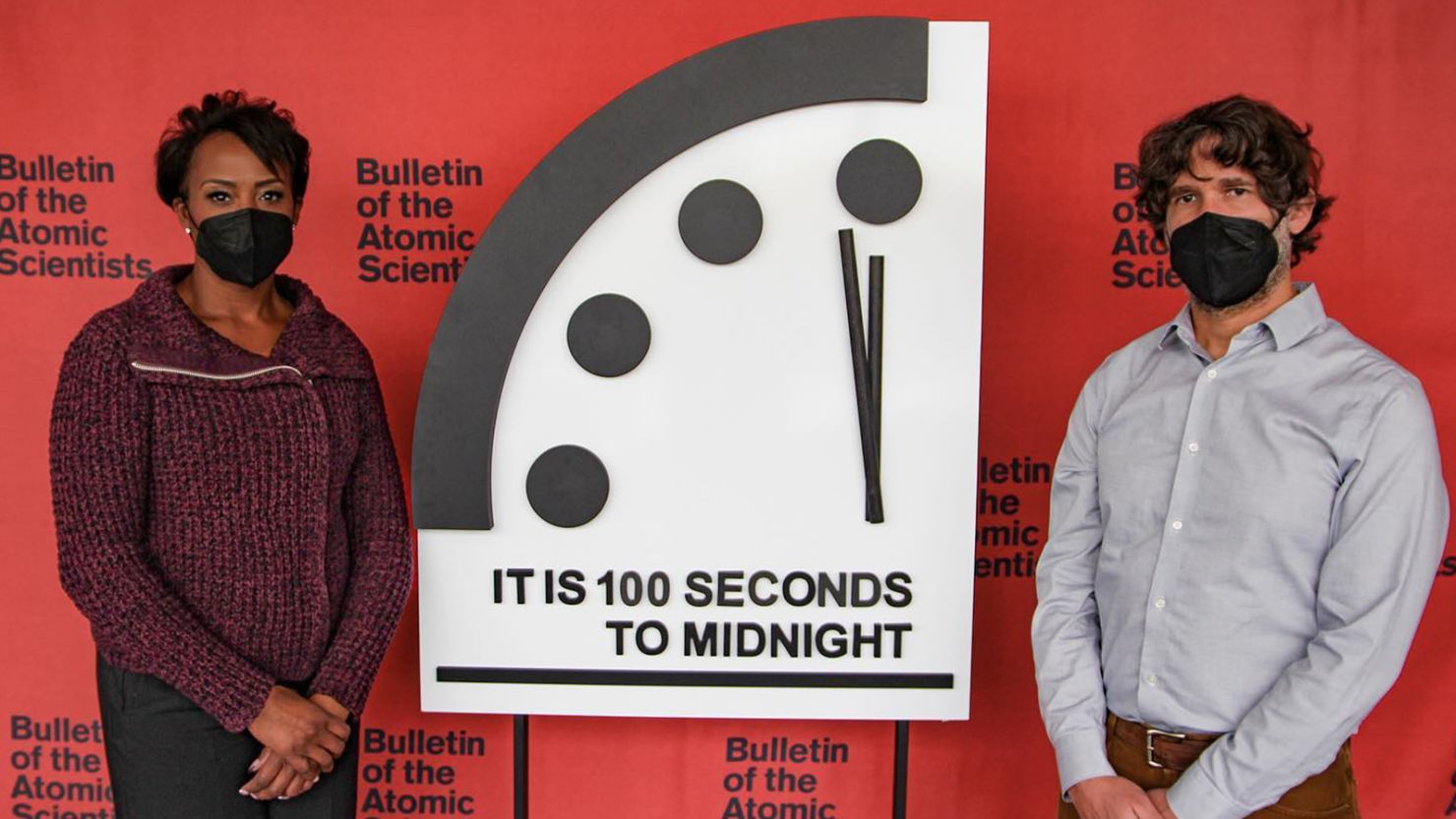The Doomsday Clock has been ticking for exactly 75 years. But it’s no ordinary clock.
It attempts to gauge how close humanity is to destroying the world.
On Thursday, the clock was set at 100 seconds until midnight – the same time it has been since 2020.
The clock isn’t designed to definitively measure existential threats, but rather to spark conversations about difficult scientific topics such as climate change, according to the Bulletin of Atomic Scientists, which created the clock in 1947.
“One hundred seconds to midnight reflects the Board’s judgment that we are stuck in a perilous moment – one that brings neither stability nor security. Positive developments in 2021 failed to counteract negative, long-term trends,” said Sharon Squassoni, co-chair of the Bulletin’s Science and Security Board, which sets the clock. Squasson is also a research professor at the Institute for International Science and Technology Policy at The George Washington University.
What is the Doomsday Clock?
The Bulletin of Atomic Scientists was a group of atomic scientists who worked on the Manhattan Project, the code name for the development of the atomic bomb during World War II.
Originally, it was conceived to measure nuclear threats, but in 2007 the Bulletin made the decision to include climate change in its calculations.
Over the last three-quarters of a century, the clock’s time has changed, according to how close the scientists believe the human race is to total destruction. Some years the time changes, and some years it doesn’t.
The Doomsday Clock is set every year by the experts on the Bulletin’s Science and Security Board in consultation with its Board of Sponsors, which includes 11 Nobel laureates.
Although the clock has been an effective wake-up call when it comes to reminding people about the cascading crises the planet is facing, some have questioned the 75-year-old clock’s usefulness.
“It’s an imperfect metaphor,” Michael E. Mann, climate scientist at Pennsylvania State University, told CNN, highlighting that the clock’s framing combines different types of risk that have different characteristics and occur in different timescales. Still, he adds it “remains an important rhetorical device that reminds us, year after year, of the tenuousness of our current existence on this planet.”
Theoretical physicist and former member of the Bulletin’s Board of Sponsors Lawrence Krauss said it can be difficult to take the clock’s results seriously since it’s been ticking dangerously close to the end of civilization in the last few decades. Each year, he said, as the clock nears midnight, scientists would have to gauge how much available “real estate” is left before deciding on how much farther to move the clock.
“Now, it ticks in seconds; it used to be minutes,” Krauss told CNN. “It is clearly not a quantifiable scientific assessment, more of a qualitative one. What has always been important is the movement of the clock, not its absolute value.”
Every model has constraints, said Eryn MacDonald, analyst with the Union of Concerned Scientists’ Global Security Program, adding that the Bulletin has made thoughtful decisions each year on how to get the people’s attention about existential threats and the required action.
“While I wish we could go back to talking about minutes to midnight instead of seconds, unfortunately that no longer reflects reality,” she told CNN.
What happens if the clock reaches midnight?
The clock has never reached midnight, and Rachel Bronson, Bulletin president and CEO, hopes it never will.
“When the clock is at midnight, that means there’s been some sort of nuclear exchange or catastrophic climate change that’s wiped out humanity,” she said. “So we never really want to get there and we won’t know it when we do.”
How accurate is the clock?
The clock’s time isn’t meant to measure threats, but rather to spark conversation and encourage public engagement in scientific topics like climate change and nuclear disarmament.
If the clock is able to do that, then Bronson views it as a success.
When a new time is set on the clock, people listen, she said. At the COP26 climate talks in Glasgow, UK Prime Minister Boris Johnson cited the Doomsday Clock when talking about the climate crisis the world is facing, Bronson noted.
Bronson said she hopes people will discuss whether they agree with their decision and have fruitful talks about what the driving forces of the change are.
It’s still possible to move the clock back with bold, concrete actions. In fact, the hand has moved farthest away from midnight with a whopping 17 minutes before midnight in 1991, when President George H.W. Bush’s administration signed the Strategic Arms Reduction Treaty with the Soviet Union. In 2016, the clock was at three minutes before midnight as a result of the Iran nuclear agreement and the Paris climate accord.
What can an individual do to turn back time on the clock?
Don’t underestimate the power of talking about these important issues with your peers, Bronson said.
“You might not feel it because you’re not doing anything, but we know that public engagement moves (a) leader to do things,” she said.
For climate change, look at your daily habits and see if there are small changes you can make in your life such as how often you walk versus drive and how your home is heated, Bronson explained.
Correction: An earlier version of this story misstated the number of Nobel laureates on the Bulletin of Atomic Scientists’ Board of Sponsors.





